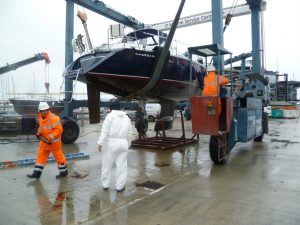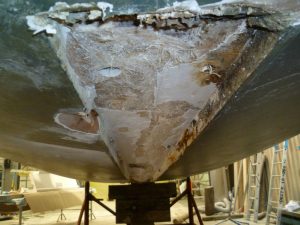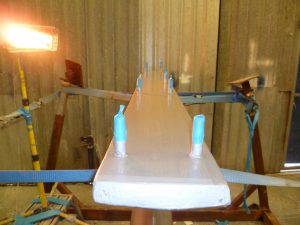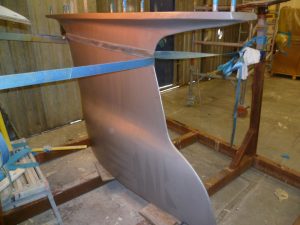Experiences & Tips
Tips and experiences from Maxi Owners
Replacement of the sail-drive gaiter is a recurring task for Maxi owners and one that is costly through a yard. Malcolm (Denny) Denham has done it himself on his Maxi 1100 and has kindly shared with the group his experience. The pdf file below includes the lessons learned and has pictures through the procedure while the Excel file includes materials used and time taken.
https://maxiowners.net/wp-content/uploads/2022/04/Saildrive-diaphragm-replacement.pdf
https://maxiowners.net/wp-content/uploads/2022/04/Saildrive-diaphragm-change.xlsx
Many thanks Denny for sharing with the group.
There has been much discussion in the sailing media and the MOA WhatsApp group about biodiesel and diesel additives. From the WhatsApp group, it appears we have an expert in our membership with Malcolm Denham having written an article on biodiesel which appeared in Cruising Magazine in December 2021 www.theca.org.uk. Please find here a link to the article reproduced with their permission.
https://maxiowners.net/wp-content/uploads/2022/04/Cruising-Dec-21-HVOs-final.pdf
Peter Stonestreet suggested that I write up my experience of removing the keel from my 1997 Maxi 34 a year or two ago as, after the tragedy of Cheeky Raffiki, this is a topical subject. The story starts with us purchasing Ariam from Roger Moon at SD Marine in 2012. She had been chartered for most of her life and we paid an appropriate price, although being a Maxi she was fundamentally sound. After a season I noticed that the bilges were never completely dry and began looking for what must be a small, but persistent leak. On a reach to starboard, the discovery of a thin, pulsing trickle of seawater appearing from a crack in a section of fibreglass fillet at the aft end of the keel, indicated the potential source.
Deep gloom descended as my first reaction was that Ariam must have been grounded hard at some stage in her life, but Neil Desty (of Destys at Hamble Point) kindly came up to Kemps Quay to inspect the hull internally. His view was that this had not the case and the structure was in perfect condition. He was reluctant to remove the keel as “you really, really don’t want to take the keel off a Maxi” but we agreed that the only way to pin down the leak was to drop the keel. Thus Ariam was de-rigged and lifted out at Hamble Point. With all 8 keel bolt nuts undone, you might have expected the keel to come away with little resistance, but not so. After hours in the slings and much heaving and hammering from above, Desty’s troops suggested it would be better for the owner not to watch the next stage of the process. This involved cutting scallops of material out of the fibreglass, front and rear and either side of the keel, and inserting crowbars to lever the keel out of its socket. With an almighty ‘bang’ the keel eventually disconnected and sat upright in the dunnage prepared for it.
A thin, black line along the sealant indicated where water was entering through a crack at the forward end of the keel, seeping along its length and emerging through a keel bolt hole at the rear, then out through the fillet. I took the opportunity to have some corrosion pits in the keel filled, after slurry blasting the cast iron. Destys then re-coppercoated it, cleaned out the keel slot and refitted the keel with new sealant. Ariam has been bone dry ever since.
The point I took home from this was that the keel attachments in the Maxi 1000/ Maxi 34 hull are immensely well engineered. First of all the keel fits into a 2″ deep slot in the hull, ensuring there is plenty of solid fibreglass structure around it. Secondly the bending moment the keel imposes on the hull, as the boat heels, is reacted over a wide area due to the flat, flared-out top section of the keel. This makes the keel more expensive to cast, but has the added benefit of allowing the 8 keel bolts to be staggered athwartships, further spreading the load. I am very happy to see how well the boat is constructed and have no worries about the keel detaching at sea.
Mind your step
At this time of year when you are polishing hulls, the multistep platforms are a real boon. After years of borrowing a friend’s, I bought my own.
Unlike my friends old steps, the

Steps use with caution
platform on the new ones do not join together but simply have clips that locate on the rungs that are meant to stop the platform sliding off. “Meant to” being the operative words! One platform extends past the hinge and, as the ladder bent a bit in the middle under my weight, the clips disengaged from the rungs sending me falling through the rungs on the ladder skinning my shin and damaging my hip – it could have been worse. If you have one of these ladders – a top tip is to find some way to join the two platforms together.
A Seamanship Challenge – What would you do?
Radar Assisted Collision – the risk
This true story is taken from an MAIB report, YM article and discussion between professional seafarers. Further reading, arithmetic and layout with paper and compass is valuable.
The Liquefied Petroleum Gas (LPG) carrier, Gas Monarch, collided with the sailing yacht, Whispa, in dense fog 6 miles ESE of Lowestoft.
Gas Monarch was proceeding at full speed, in fog, when her master left the bridge in the hands of his third officer (3/O) and an able bodied seaman (AB), contrary to his own standing orders. Whispa appeared out of the fog on a crossing course at very short range. Evasive action by both craft was unsuccessful and the vessels collided. Continue reading




